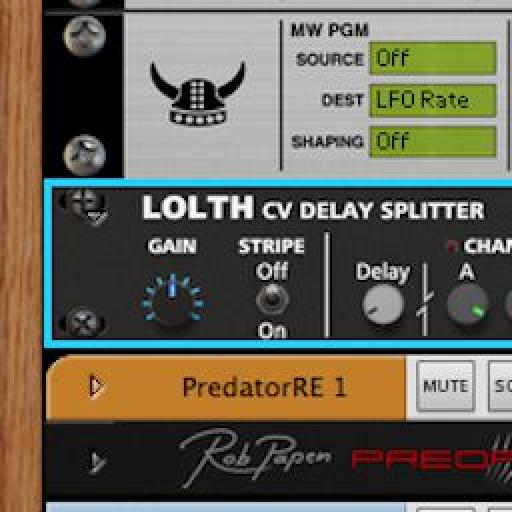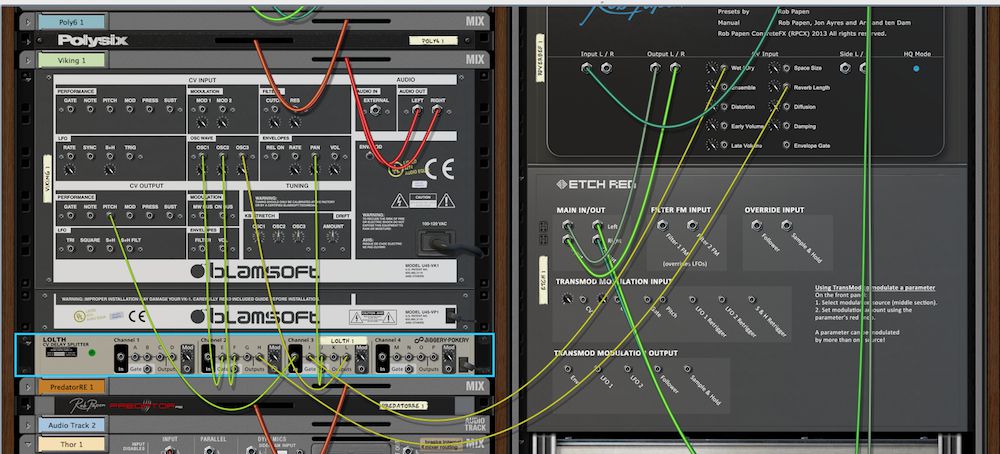In my recent 'Reason - Advanced MIDI Workshop' course, I introduced the idea of creating large 'Super Modulated' instruments that consist of multiple Combinators and instruments. These separate devices are then hooked up via the CV/Gate system to produce crazy modulation routings and interested sonic textures.
If you want to see the whole thing in action I would suggest you take a look at the course, but let's break down the different methods that can be used here and how we can get the separate devices to communicate.
1 - Sequencers Rule
During the Advanced MIDI course, I tended to opt for some kind of sequencer as the heart of these larger than life instrument systems. This is really down to the fact you can create a pattern in the Matrix, Thor or ReDrum and let it run while you tweak everything else. But apart from this, these sequencers output their patterns very easily as CV/Gate data.
Sequencers are an ideal tools for outputting CV/Gate data.
This clock-like output can be routed to any other device in just a few moves. On top of this, the majority of the sequencers in Reason have the ability to output automation-like data in the form of a 'Curve' mode. This can be used to manipulate any parameter that will take a CV input but is especially useful when it comes to things like volume and filter cutoff.
The Matrix Sequencer doing its thing.
Once you are done with working in these sequencers, the parts can always be sent to a MIDI track and edited further. They are just a good place to start when working with large amounts of CV data in this way.
2 - Drum Triggers
It's not just synthesizers that can be triggered by this sort of CV setup, and Reason's sequencers, drums are also an excellent destination. Kong is probably the best candidate for this sort of triggering as it lacks its own internal sequencer.
CV routings can be used to trigger drums as well as route modulators.
By hooking up a ReDrum to Kong via CV/Gate, it is possible to use the ReDrum's internal sequencer to completely control Kong. I find this a really satisfying way of working because not only can you take advantage of all of Kong's internal sound creation tools but you can enjoy retro-style step sequencing from the ReDrum.
When connected correctly new capabilities can be added to Kong.
Hooking the two instruments up does take a little bit of legwork and involves routing every slot of the ReDrum to individual pads of the Kong. Once this is complete, you have possibly the most complete drum solution in Reason. And remember this can then be saved as a Combinator!
3 - Simple Interconnects
When starting to build large instrument structures and creating CV-based interconnections, there are really a few levels of complexity. First up we have the straight up 'simple' interconnects.
These more basic connection would be similar to the 'sequencer connected to a synthesizer' type of setup we discussed earlier. This is simply one instrument sending a single stream of data to another.
Simple connections between instruments are an excellent way to distribute CV info.
This can be useful for using a modulation source from one instrument with another. For example, if you run out of envelopes, LFOs, or even external modulation sources, you can quickly utilize these features from a secondary instrument.
Obviously this sort of connection is perfect when you are using only two instruments. You can even use these simple connections to route multiple instruments, but when you need to share the same stream of data between various devices, you need to use mergers and splitters.
4 - Mergers And Splitters
The Spider merger and splitter units are pretty humble in their appearance and may not be the most glamorous virtual devices in the Reason rack, but they are certainly useful. In fact I find that in some situations certain routings would just not be possible without them.
Obviously we are focusing on the CV Merger/Splitter here and this device is ideal for three real purposes. We can take a single CV stream such as an LFO signal and split into 3 duplicate streams. These carbon copies can then be sent to various locations around Reason's rack allowing you to control several instruments with the same LFO, or any other mod source.
CV Mergers and Splitters allow you to create much more complex setups.
Surprisingly, you can also merge CV signals. This essentially means you can create really interesting cross modulation effects by combining several modulation sources into one destination. I tend to utilize this feature less then the splitter sections but it's there if you need it!
Finally, because there are essentially two splitter circuits, both CV and Gate can be duplicated. This means you can duplicate sequencer signals to various instruments in the rack. This is ideal for powering long lists of synths with a single Matrix sequencer and creating super layers.
5 - Third Party Plug-ins
It's not just the Props that are making CV-based devices. Check out the new releases from a company called Jiggery Pokery software in the Rack Extension store, these guys are doing some really interesting stuff and expanding Reason's CV capabilities.
There are also excellent third party Rack Extensions for your CV signals.
The Lolth and Miranda for example may just appear to be CV merger and splitter devices, but they also add delay capabilities to the mix. This means you can add varying delays to your CV streams creating even more complex cross modulations between your instruments.
The Lolth CV Splitter in the rack.
Hopefully this has wet your appetite for creating more complex CV routings and hooking up multiple devices. The possibilities are pretty much endless, but once you start thinking about the whole thing creatively and are aware of the tools at your disposal, you should be well on your way.
If you want to see one of these systems in action or you just need to know more, you can check out my Reason Advanced MIDI workshop course and get the lowdown on all sorts of techniques for manipulating CV/Gate signals and moderation routings.











 © 2024 Ask.Audio
A NonLinear Educating Company
© 2024 Ask.Audio
A NonLinear Educating Company
Discussion
Want to join the discussion?
Create an account or login to get started!